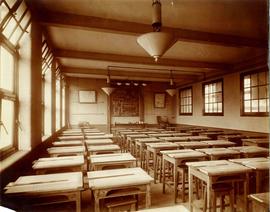Contains publications on the opening of a new laboratory (NC/2/3/1) and new College building (NC/2/3/2-3).
National College for Heating, Ventilating, Refrigeration and Fan EngineeringComprises photos of University's buildings, including some that are no longer part of the University's holdings.
Board of GovernorsBound minutes of the Building Sub-Committee. The majoirty of minutes are from 1926-1936, with a loose insert of the May 1944 minutes.
House CommitteeIssue 3
Building Service DepartmentComprises architectural drawings and building plans for Polytechnic and University buildings and maps of the Southwark campus.
Board of GovernorsBlack and white and colour photographs, slides and negatives and digital images of ceremonies for the opening of new buildings and other historic Polytechnic and University events.
Borough Polytechnic InstituteBooklet describing proposals for the building of the Keyworth 2 building [K2] and the St George's II development. Plans for St George's II subsequently changed. The booklet also details the improvements the developments would supply for the Departments of Health and Social Care and Education.
London South Bank UniversityDrawings, paintings and prints of various Southwark Campus buildings.
Borough Polytechnic InstituteNotes, lecture handouts and occasional sketches of equipment.
Hadley, Lawrence, OBE CEng FCIBSEA photograph of the builder's drawing office set out with rows of desks on the first floor of Borough Road Building.
Borough Polytechnic InstituteProgramme for the BSc Honours Engineering Product Design Degree Show held in 1998.
South Bank UniversityIn 1900 the Borough Polytechnic Institute entered into the Exposition Universelle. The Exposition was a world fair held in Paris from 15 April until 12 November 1900, to celebrate the achievements of the 19th Century and to accelerate development into the next.The minutes of the Polytechnic's Education Committee for 25th January 1900 (pg210) state; 'English Education Exhibit. A fair number of specimens had been sent to the Imperial Institute and it was expected that many of these specimens will be sent to Paris.' The 'Imperial Institute' was the South Kensington Museum which would later become the Victoria and Albert Museum. The 'specimens' from the Institute won a medal at the Exposition in Paris, which was later sent by the Royal Commission to the Polytechnic accompanied by an envelope, box, letter and advertising material.
Medal inscription, 'Republique Francaise, Exposition Universelle Internationale 1900, Borough Road Polytechnic, Bronze'
More than 50 million people attended the Paris Exposition (a world record at the time); it included more than 76,000 exhibitors and covered 1.12 square kilometres of Paris.
A number of Paris' most noted structures were built for the Exposition, including the Gare de Lyon, the Gare d'Orsay (now the Musée d'Orsay), the Pont Alexandre III, the Grand Palais, La Ruche, and the Petit Palais. The first line of the Paris Metro also began operation to coincide with the Exposition. Part of the Exposition was the Second Olympic Games, which were spread over five months. 'Talkies' (films with speech) and escalators were publicized, as was Campbell's Soup, which was awarded a gold medal (an image of which still appears on its label).
Exposition Universelle, Royal Commission